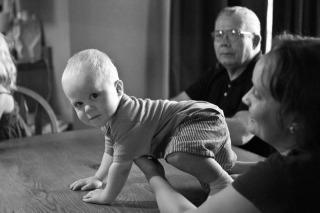Red eyes, harsh glare, shiny foreheads, ugly reflections in the window – these are not the things memories are made of. That little flash built into your camera is the number one culprit in bad photographs. It’s intrusive and distracting, pulling attention away from the scene being photographed and toward the photographer. Think of it as a last resort. If you absolutely have to get a picture, and it is really dark, go ahead and use it. But how often is it that dark?
With the newer crop of digital cameras allowing the use of high ISO’s, and ever improving lenses that open up to wider apertures, we can shoot in dimmer and dimmer light without resorting to on-camera flash. Below are some tips to help you get the best photos you can using only available light:
- Crank up that ISO. You will see a lot written about the horrors of noise in your digital files, and you will see noise, no doubt about it. But most everyone has moved on to cameras with 8, 10, 12, or even 14 megapixels. This is much more resolution than you actually need for a 4X6 or 5X7 print. So even if the noise looks bad blown up huge on the monitor, it will be much less noticeable in an actual print.
- Brace yourself. When you are not using flash, you will have to use slower shutter speeds to let enough light hit the sensor to capture a properly exposed image. The problem with slower shutter speeds, is movement. If the camera moves while the shutter is open, you will get a blurry picture. Your mission is to minimize this movement. Stand as if you were on a moving train/bus, feet apart and knees slightly bent, and squeeze your elbows against your sides as you hold the camera. Ideally, there would be a wall nearby that you could lean against. Finally, gently press the shutter release, don’t mash it.
- Anticipate the action. Just like camera movement, subject movement will cause blurry pictures. The best way to counteract this is to pre-focus your camera on your subject and wait for a slight pause in their motion. This is especially important with kids, they are little balls of energy. Also, pictures with motion blur can be really interesting. They are much better than pictures that are simply out of focus. Embrace this.
- Learn to love black & white. When shooting with the available light, you are likely to have orange light from standard bulbs, green light from fluorescent bulbs, and blue light from the window all mixing together in one scene. Neutralize all these color casts by simply switching the image to black and white. One added benefit, the noise mentioned in tip one (above) looks much more like classic film grain once the image is converted to black & white.
As you practice these techniques, you will get much more comfortable shooting without the flash. You should also start to get more interesting images that look more like something you would see in a newspaper or magazine and less like a snapshot in a photo album.
Tech Info:
This is certainly not the greatest photograph that I have ever made, but I think is does a good job of illustrating the points mentioned in the blog post. Just click on the image to see it larger.
Nikon D70s (This is an old 6 megapixel DSLR)
Nikon 35mm f2 lens (An inexpensive fixed, non-zoom, lens that opens to a wide aperture)
ISO 1250 (This camera maxes out at ISO 1600)
No Flash
Mixed lighting – Window, standard light bulbs & fluorescent tubes
Converted to B&W in Adobe Camera Raw
